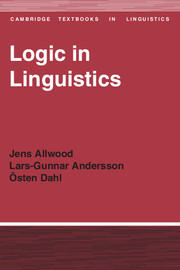Book contents
- Frontmatter
- Contents
- Preface
- Symbols and notational conventions
- 1 Logic for linguists
- 2 Set theory
- 3 Inference and logical analysis of sentences
- 4 Propositional logic
- 5 Predicate logic
- 6 Deduction
- 7 Modal logic
- 8 Intensional logic and categorial grammar
- 9 Further extensions
- 10 Logic for linguists?
- References
- Answers to exercises
- Index
4 - Propositional logic
Published online by Cambridge University Press: 05 June 2012
- Frontmatter
- Contents
- Preface
- Symbols and notational conventions
- 1 Logic for linguists
- 2 Set theory
- 3 Inference and logical analysis of sentences
- 4 Propositional logic
- 5 Predicate logic
- 6 Deduction
- 7 Modal logic
- 8 Intensional logic and categorial grammar
- 9 Further extensions
- 10 Logic for linguists?
- References
- Answers to exercises
- Index
Summary
Connectives
Logical relations between simple sentences that are part of a compound sentence are usually determined by certain words called sentential (or propositional) connectives. A sentential connective is a word or phrase usually belonging to the traditional grammatical category of conjunction (and, or, therefore, because, since, but, before, as, even though and if … then).
In the following examples it is clear that the connectives combine sentences in logically distinct ways.
(1) Bill is a syndicalist even though he reads Burke
(2) Bill is a syndicalist and he reads Burke
(3) Bill is a syndicalist or he reads Burke
In all three cases two sentences are combined, but with different effects depending on the connective chosen.
That we are really dealing with different logical relations can best be seen from the conclusions we can draw from the three sentences. From (1) it follows roughly that one does not expect a syndicalist to read Burke. From (2) and (3) no such conclusion can be drawn. (3) does not even imply that both sentences are true but only that at least one of them is true.
The logical form provided by the sentential connectives therefore determines the logical consequences of the sentences that have been related by the connectives.
- Type
- Chapter
- Information
- Logic in Linguistics , pp. 26 - 57Publisher: Cambridge University PressPrint publication year: 1977

